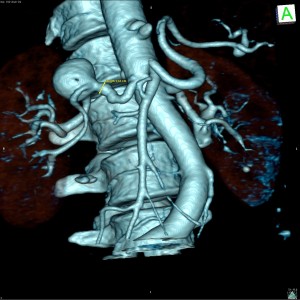WHAT IS AN ANEURYSM?
An aneurysm is a weakening the wall of an artery, causing the artery to bulge. The entire circumference of the artery may bulge (fusiform aneurysm), or there may be a focal ballooning from a section of the arterial circumference (saccular aneurysm). In the abdomen, this may affect the aorta (the largest blood vessel in the abdomen) or affect arteries supplying the kidneys, intestines, liver and spleen.
HOW IS AN ANEURYSM DIAGNOSED?
 Aneurysms may be discovered on cross-sectional imaging (such as a CT scan). Often, they are asymptomatic and are only discovered on a scan that is requested for another reason. Good spatial understanding of the aneurysm can be performed with a CT angiogram (CTA). A high quality CT angiogram can define an aneurysm well, telling us important features of the aneurysm including its size, the number of arteries it involves, its shape and the size of the aneurysm neck. All of these are important factors in dictating the treatment options. In some cases, a formal angiogram may also be required.
Aneurysms may be discovered on cross-sectional imaging (such as a CT scan). Often, they are asymptomatic and are only discovered on a scan that is requested for another reason. Good spatial understanding of the aneurysm can be performed with a CT angiogram (CTA). A high quality CT angiogram can define an aneurysm well, telling us important features of the aneurysm including its size, the number of arteries it involves, its shape and the size of the aneurysm neck. All of these are important factors in dictating the treatment options. In some cases, a formal angiogram may also be required.
WHY TREAT AN ANEURYSM?
The main reason for treating an aneurysm is to prevent its most serious complication: rupture. The absolute risk of visceral aneurysm rupture is still uncertain and probably low. However, we know that risk of rupture increases with aneurysm size, increased aneurysm growth and pregnancy. A ruptured aneurysm is serious and potentially fatal.
Aneurysms may also be symptomatic if they compress adjacent structures, or clot forms within the aneurysm cavity.
HOW IS AN ANEURYSM TREATED?
 Due to new endovascular techniques, the need for open surgery is rare. The goal of aneurysm treatment is to exclude the aneurysm from the arterial circulation, whilst preserving the parent artery. This is normal done by filling the aneurysm sac with embolisation coils. In more complex cases, balloons (which are temporarily inflated) and stents (which are permanently implanted) may be used in order to maintain the patency of the parent artery whilst the aneurysm is being packed with coils. In some instances, the aneurysm may be treated with an endovascular graft. Rarely, if the aneurysm involves an artery that is not vital, the aneurysm and the arterial branches may be embolised (occluded) thus excluding it from the circulation and preventing it from rupturing.
Due to new endovascular techniques, the need for open surgery is rare. The goal of aneurysm treatment is to exclude the aneurysm from the arterial circulation, whilst preserving the parent artery. This is normal done by filling the aneurysm sac with embolisation coils. In more complex cases, balloons (which are temporarily inflated) and stents (which are permanently implanted) may be used in order to maintain the patency of the parent artery whilst the aneurysm is being packed with coils. In some instances, the aneurysm may be treated with an endovascular graft. Rarely, if the aneurysm involves an artery that is not vital, the aneurysm and the arterial branches may be embolised (occluded) thus excluding it from the circulation and preventing it from rupturing.
Embolisation of these aneurysms is normally performed as a day-only procedure. In some cases, an overnight stay is recommended for precautionary observation.
 The procedure should be performed in an angiography suite with high quality X-ray equipment. Access to the arterial system is gained from the a small puncture in the artery at the top of the leg. An angiogram (injection of x-ray dye) is then performed to outline and delineate the aneurysm. Small micro catheters are then advanced to the aneurysm through which coils, stents and balloons may be deployed. Repeat angiography confirms adequate placement and volume of the coils. The puncture site in the groin is then normally closed with a suture or plug device.
The procedure should be performed in an angiography suite with high quality X-ray equipment. Access to the arterial system is gained from the a small puncture in the artery at the top of the leg. An angiogram (injection of x-ray dye) is then performed to outline and delineate the aneurysm. Small micro catheters are then advanced to the aneurysm through which coils, stents and balloons may be deployed. Repeat angiography confirms adequate placement and volume of the coils. The puncture site in the groin is then normally closed with a suture or plug device.

